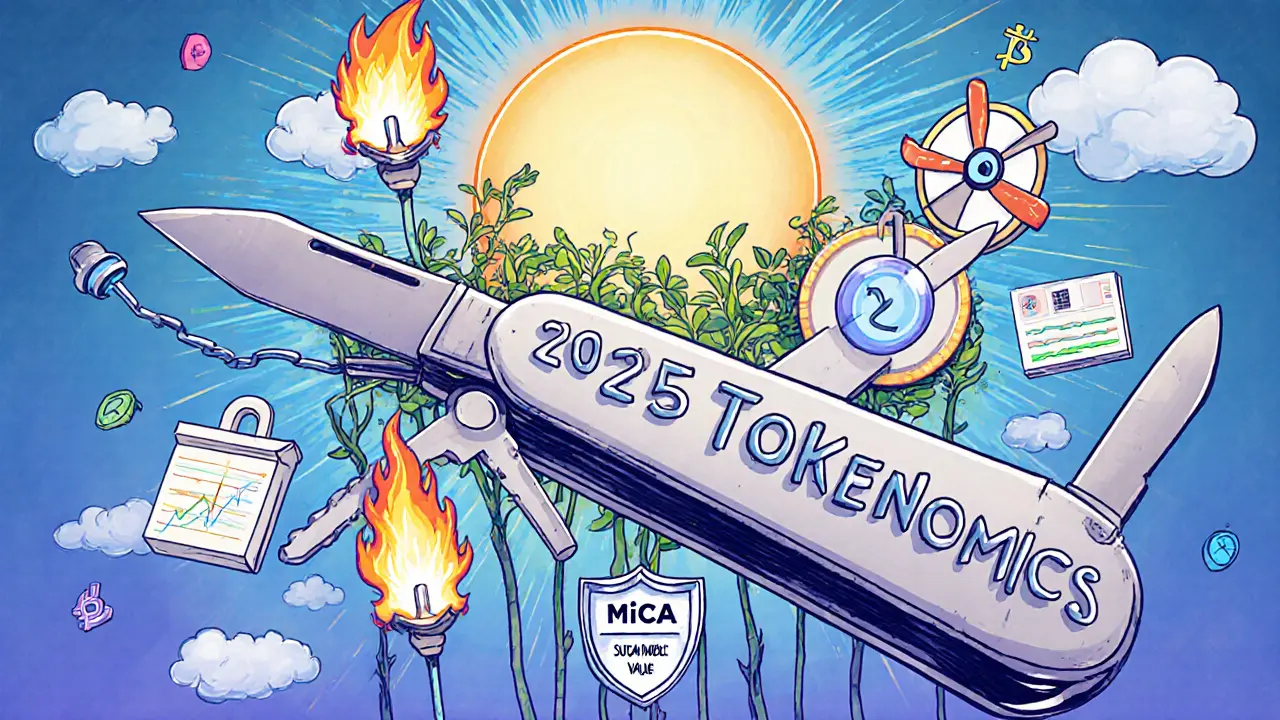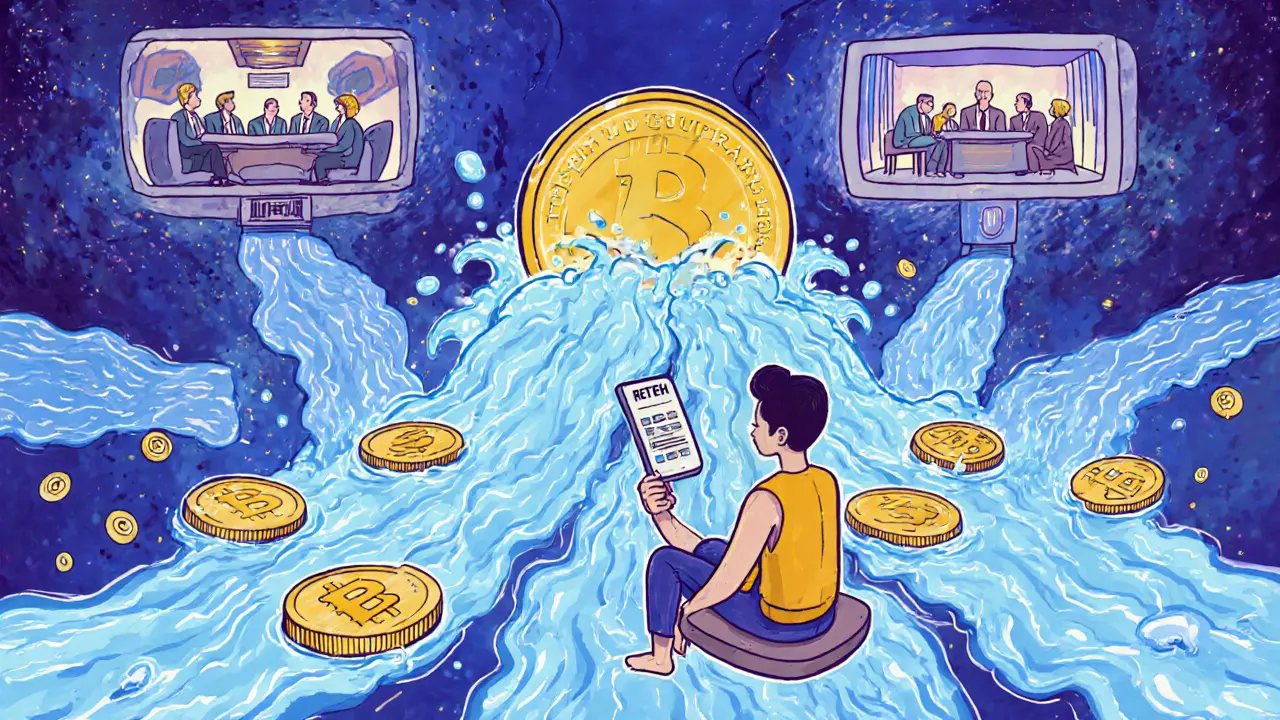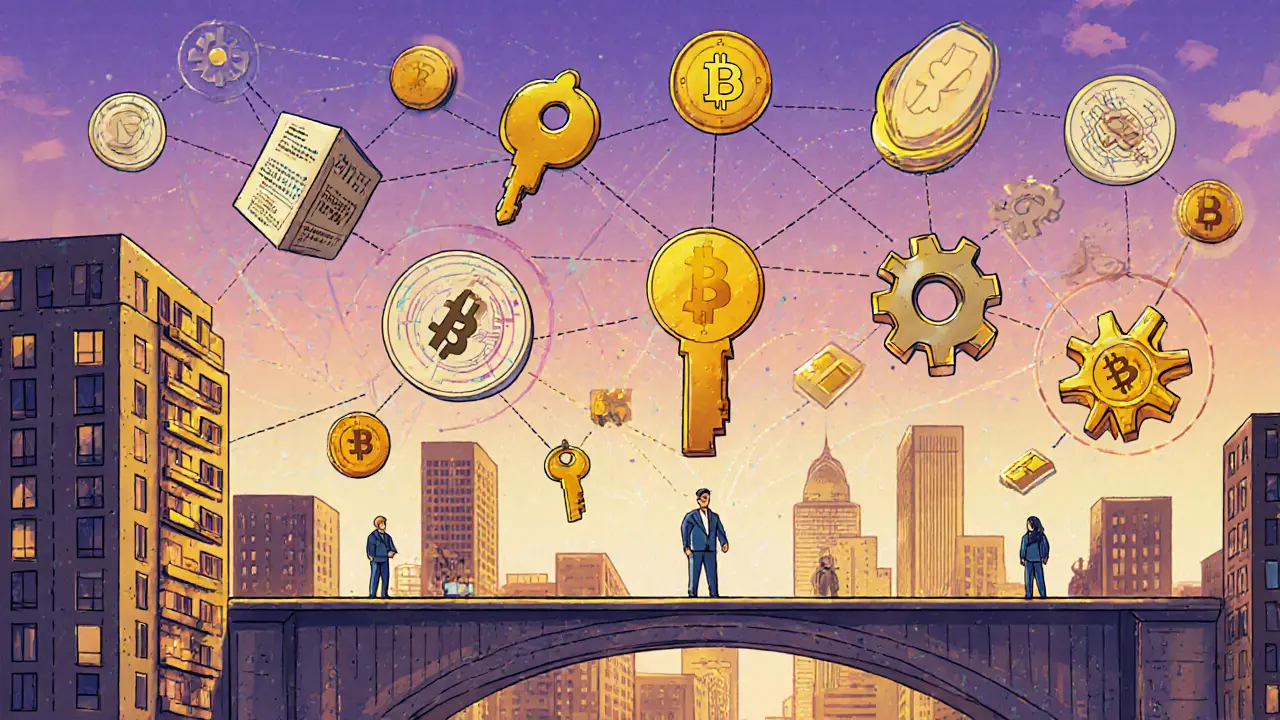Tokenomics Sustainability Calculator
Tokenomics Sustainability Assessment
Evaluate your tokenomics design against the four pillars of sustainable tokenomics: continuous value generation, risk mitigation, balanced supply/demand, and transparent governance.
Value Generation
Select features that generate real value (e.g., transaction fees, service access, governance rights)
Risk & Compliance
Select security measures and compliance elements
Supply & Demand
How does your token manage supply and demand?
Does token work with Liquid Restaking Tokens?
Governance
How is governance implemented?
How transparent is the governance process?
Results
Tokenomics isn’t just about how many tokens a project prints or how often it burns them anymore. In 2025, it’s the backbone of whether a blockchain project survives-or thrives. Early crypto projects got by with simple models: fix a supply, add a staking reward, hope people buy in. That’s over. Today’s successful tokenomics designs are complex, regulated, and deeply tied to real-world value. They don’t just move digital tokens; they move money, property, and trust.
From Speculation to Substance
Five years ago, a token’s price was mostly driven by hype, influencer tweets, and FOMO. Now, investors look at the economic engine behind the token. Does it have real utility? Is demand being created by actual usage, or just speculation? The shift is clear: projects with weak tokenomics are getting filtered out. Those with strong, sustainable models are attracting institutional capital. Take real-world asset (RWA) tokenization. By 2030, experts project over $1.5 trillion in physical assets-real estate, bonds, commodities-will be represented as digital tokens. That’s not theory. It’s happening. A New Zealand-based fund just tokenized a portfolio of commercial properties, allowing global investors to buy fractional shares via a regulated blockchain. The token isn’t a gamble-it’s a deed. And that changes everything.Regulation Isn’t the Enemy-It’s the Foundation
In 2025, ignoring regulation is suicide. The EU’s MiCA regulation and stricter SEC enforcement aren’t slowing innovation; they’re cleaning up the space. Projects that built tokenomics with compliance baked in are now the ones raising funds from traditional investors. Transparency isn’t optional anymore. Token distribution maps, vesting schedules, and treasury controls must be public and verifiable. This isn’t about censorship. It’s about credibility. A token that can’t prove it’s not a security? It won’t get listed on major exchanges. A DAO that can’t show how decisions are made? No institutional partner will touch it. The best tokenomics designs now include legal guardrails from day one-smart contracts that auto-enforce holding periods, KYC checks at the wallet level, and audit trails for every transaction.The Rise of Multi-Mechanism Systems
Modern tokenomics doesn’t rely on one trick. It uses layers. Think of it like a Swiss Army knife: burn fees to reduce supply, stake tokens to earn rewards, lock them in governance to vote on upgrades, and use them to pay for services on the platform-all at once. Projects like EigenLayer and Pendle are leading the charge. EigenLayer lets users restake their ETH to secure other blockchains, earning extra rewards without giving up their original stake. Pendle lets users trade future yield streams as tokens, turning staking rewards into liquid assets. These aren’t gimmicks. They’re economic innovations that turn passive holdings into active capital. The key? Balance. Too much burning? Supply drops too fast, holders panic. Too many rewards? Inflation eats value. The best designs use dynamic algorithms that adjust rewards based on network usage, token price, and liquidity levels. They’re not static spreadsheets-they’re living economies.
DAOs and DeFi Are Merging
Decentralized Autonomous Organizations used to be slow, clunky voting systems where only a few active members made decisions. Now, DAOs are integrated into DeFi protocols. Your DAO token isn’t just a vote-it’s a financial instrument. You can now stake your DAO token on Aave to earn interest, use it as collateral on MakerDAO to borrow stablecoins, or provide liquidity on Uniswap to earn trading fees. This convergence turns governance tokens into utility tokens with real yield. It’s no longer about holding a token to vote on a proposal-it’s about holding it to make money while you vote. This creates a powerful feedback loop: more utility → more demand → higher token price → more participation → stronger governance. Projects like Aragon and Snapshot are building tools that let DAOs automate these integrations, so governance isn’t just a forum-it’s a financial ecosystem.Liquid Restaking Tokens (LRTs) Are the New Frontier
If you thought staking was the peak of capital efficiency, think again. Liquid Restaking Tokens (LRTs) are taking it further. With LRTs, you stake your ETH on Ethereum to help secure the network. But instead of locking it up, you get a token-like lsETH or rETH-that represents your staked ETH and can be traded, lent, or used in DeFi. This isn’t just convenience. It’s economic multiplication. Your ETH now secures Ethereum *and* powers lending protocols, derivatives markets, and insurance pools-all at the same time. The result? More security for the network, more yield for users, and more liquidity for the entire Web3 ecosystem. By mid-2025, LRTs had over $40 billion in total value locked. That’s not a niche experiment-it’s becoming infrastructure. The future of tokenomics isn’t just about your token. It’s about how your token connects to everything else.The Four Pillars of Sustainable Tokenomics
No matter how fancy the mechanism, all successful tokenomics designs share four core principles:- Continuous value generation: Tokens must create or capture value regularly-through fees, usage, or services-not just speculation.
- Risk mitigation: Smart contracts must be audited, ownership concentrated? Fix it. Centralized treasury? Make it multisig. Security isn’t a checkbox-it’s the foundation.
- Balanced supply and demand: If no one needs the token for anything, its price will crash. Utility drives demand. Simple as that.
- Transparent governance: If token holders can’t trust how decisions are made, they’ll leave. Clear voting rules, public proposals, and fair representation matter more than ever.

Who Controls the Future?
One of the biggest tensions in modern tokenomics is centralization vs. decentralization. Too much control in a small group? You get a centralized company with a blockchain label. Too much democracy? You get gridlock. A DAO that can’t upgrade its protocol because 5% of holders block every change is useless. The solution? Hybrid governance. Some decisions-like treasury spending or core protocol upgrades-require supermajorities or delegated voting. Others-like community grants or marketing budgets-are handled by smaller, rotating committees. The best systems let users choose their level of involvement: passive holders get yield, active participants get voting power, developers get funding.What Happens If You Get It Wrong?
Bad tokenomics doesn’t just fail quietly. It collapses spectacularly. Remember the TerraUSD crash? It wasn’t just a broken algorithm. It was a flawed incentive structure: users were paid high yields to hold a stablecoin, but the system had no real collateral backing it. When confidence dropped, the whole thing unraveled. Today, projects that ignore demand drivers-like real usage, network activity, or partnerships-face the same fate. Tokens with no utility, no compliance, and no clear path to value creation are disappearing from exchanges. Investors are learning: if you can’t explain how the token earns its price, don’t buy it.The Bottom Line
The future of tokenomics isn’t about creating the biggest airdrop or the flashiest yield farm. It’s about building economies that last. It’s about tokens that serve a purpose beyond trading. It’s about aligning incentives so that users, developers, and investors all benefit over time. The projects winning in 2025 aren’t the ones with the most hype. They’re the ones with the most thoughtful design. The ones that treat tokenomics like a financial system-not a marketing tool. And that’s where the real opportunity lies.What makes a tokenomics model sustainable?
A sustainable tokenomics model generates continuous value through real utility-like transaction fees, governance rights, or access to services-while balancing supply and demand. It includes strong risk controls, transparent governance, and mechanisms that reward long-term participation over short-term speculation.
How are real-world assets changing tokenomics?
Real-world asset tokenization turns physical assets-like property, bonds, or commodities-into digital tokens on a blockchain. This gives tokens intrinsic value backed by tangible assets, reducing speculation and attracting institutional investors. It bridges traditional finance with Web3, making tokenomics more stable and credible.
What are Liquid Restaking Tokens (LRTs)?
Liquid Restaking Tokens (LRTs) allow users to stake their crypto assets-like ETH-while still using them in DeFi protocols. Instead of locking up their tokens, users receive a liquid token that represents their staked position and can be traded, lent, or used as collateral. This boosts capital efficiency and security across multiple blockchain networks.
Why is regulatory compliance important in tokenomics now?
Regulatory frameworks like MiCA and SEC guidelines now require transparency in token distribution, usage, and governance. Projects that ignore compliance risk being delisted, fined, or shut down. Compliance isn’t a barrier-it’s a trust signal that attracts serious investors and enables institutional adoption.
Can DAO tokens be used like regular financial assets?
Yes. Today’s DAO tokens often double as DeFi assets. You can stake them for yield, use them as collateral for loans, or provide liquidity on decentralized exchanges. This integration turns governance tokens into multi-functional financial instruments, increasing demand and locking in long-term holders.

This whole tokenomics thing is just Wall Street with a blockchain tattoo. They’re repackaging old scams and calling it ‘innovation.’ Remember when we used to just HODL and hope? Now it’s all ‘liquid restaking’ and ‘multi-mechanism systems’-like if a finance bro took Adderall and wrote a PhD thesis on crypto. Give me back my 2021 memes.
Actually, the shift is way more nuanced. The real breakthrough isn’t just token mechanics-it’s the integration of on-chain compliance. KYC-at-wallet, audit trails, and programmable vesting aren’t just features-they’re the new minimum viable product. Projects skipping this are already dead. Look at how EigenLayer’s restaking model doesn’t just boost security-it creates a market for risk distribution. That’s not hype. That’s infrastructure.
Let’s be honest: this entire narrative is a corporate PR fantasy. The ‘four pillars’? Cute. But the truth is, 90% of these ‘sustainable’ tokenomics models are just Ponzi mechanics with a whitepaper. They use words like ‘utility’ and ‘governance’ to mask the fact that the team still controls 30% of the supply and dumps it on the first bull run. And don’t get me started on LRTs-those are just leveraged yield traps dressed up as innovation. If you think this is ‘financial evolution,’ you haven’t been paying attention to history.
Every time someone says ‘real-world asset tokenization,’ I hear ‘SEC is coming for you.’ The moment a token is backed by a deed, it becomes a security. And guess what? The SEC doesn’t care if you call it a ‘digital deed’-it’s still a security. The whole RWA push is just a legal loophole dance. And the people cheering it on? They’re the same ones who bought NFT apes.
Regulation isn’t the foundation-it’s the guillotine. The projects surviving aren’t the ones with ‘compliance baked in.’ They’re the ones who bribed lawyers and moved their HQ to Singapore. Don’t mistake opacity for sophistication.
Y’all are overcomplicating this. America built the internet. We’ll build the next financial system too. No more crypto from Europe with their ‘MiCA’ nonsense. Real money moves on US chains with real rules.
So basically, crypto’s now just a corporate tax dodge with a DAO logo? I miss when we just stole from each other and called it ‘decentralized finance.’ Now it’s all ‘risk mitigation’ and ‘transparent governance.’ BORING.
I get where you’re coming from, but I’ve seen small DAOs in Canada actually use these models to fund local clean energy projects. It’s not perfect, but when a community can vote on how to allocate $50k in token revenue to install solar panels on schools? That’s real. The tech isn’t magic-it’s just a tool. And sometimes, tools get used for good, even if the hype around them is insane.
It’s refreshing to see someone actually talk about balance instead of just ‘maximize yield.’ I’ve watched too many friends get burned chasing 200% APYs with no idea how the system works. The real win isn’t the token price-it’s building something that keeps working even when the hype dies.
There’s a deeper philosophical shift here. Tokenomics is no longer about ownership-it’s about participation in a dynamic economy. The old model treated tokens like shares. The new one treats them like membership cards to a living system. You don’t just hold ETH-you contribute to its security, earn from its activity, and influence its evolution. It’s not finance. It’s civic engagement, digitized.
This is the first time in human history that a financial system can self-correct through code and collective will. We’re not just building apps. We’re building new social contracts. And that’s terrifying. And beautiful.
The convergence of DAOs and DeFi is the most underrated development in crypto. When your governance token can earn yield, be used as collateral, and vote on protocol upgrades-all simultaneously-you’re not just holding a coin. You’re holding a stake in a self-sustaining economic organism. This isn’t speculation. It’s institutional-grade architecture.
I love how this thread is going. Even the naysayers are right in some way. The system’s messy, it’s evolving, and it’s not perfect. But if we keep tearing it down without offering better alternatives, we’re just standing in the way of progress. Let’s build smarter, not just complain louder.
It is imperative to note that the regulatory frameworks currently being implemented are not impediments to innovation, but rather mechanisms for ensuring the integrity of market participants. The absence of such frameworks in prior iterations of blockchain-based financial instruments resulted in systemic vulnerabilities that ultimately eroded public trust. The current paradigm reflects a maturation of the ecosystem, not a restriction of its potential.
LRTs? More like ‘Liquidity Risk Traps.’ Everyone’s acting like this is genius, but it’s just leverage stacked on leverage. You stake ETH → get lsETH → lend it on Aave → use it as collateral → restake the yield → compound it → and then when the market dips? Poof. Everyone’s underwater and the protocol’s insolvent. This isn’t innovation-it’s a house of cards with a blockchain logo.
Remember when we thought ‘decentralization’ meant no one was in charge? Now it’s about who gets to vote, who gets to earn, and who gets locked out. The real revolution isn’t the tech-it’s realizing that power doesn’t disappear just because you put it on a blockchain. The smartest projects now design for inclusion, not just efficiency. That’s the future.
Wait-so you’re telling me that if I stake my token, I get a liquid version of it, which I can then use to earn more yield, which I can then stake again, and the whole thing is governed by a DAO that’s run by 12 people who bought 5% of the supply in the pre-sale?!!??!!!
That’s not tokenomics. That’s a pyramid scheme with a GitHub repo.
They call it ‘hybrid governance’-but it’s just oligarchy with a voting app. The ‘rotating committees’? Still controlled by the same whales who bought early. The ‘passive holders’? Still getting fleeced. The ‘transparent treasury’? Still locked in a multisig only the founders can access. This isn’t evolution. It’s branding.
They’re using blockchain to create a global financial surveillance state. Every transaction tracked. Every wallet KYC’d. Every governance vote monitored. This isn’t freedom-it’s the Fed, but with crypto. The ‘real-world asset’ push? That’s the final step. Soon, your house, your car, your pension-all tokenized, all controlled by algorithms written in Silicon Valley. Wake up.
Hey, I get the skepticism. But I’ve seen a rural community in Nova Scotia use tokenized land shares to fund a microgrid. No banks. No middlemen. Just neighbors voting on who gets paid and how. It’s not perfect. It’s messy. But it’s real. Maybe the system’s flawed-but the idea? That’s worth fighting for.
Exactly. The critique is valid-but dismissing the entire model because of bad actors is like saying democracy doesn’t work because of corrupt politicians. The tools are neutral. It’s the design and culture around them that matter. The fact that we’re even having this conversation? That’s progress.
And yet, the same people who preach ‘decentralization’ are the ones building the most centralized systems. They just call it ‘governance’ now. The real test? Can a random person on the internet propose a change and have it executed without needing a VC’s approval? If not, it’s not a DAO. It’s a startup with a token.
Maybe we need more than just better design-we need better incentives. What if we rewarded long-term holders with voting weight, not just token count? What if we made it harder to dump after a big raise? The tech can handle it. We just need the will.
It is worth noting that the emergence of dynamic, algorithmic supply mechanisms represents a significant departure from static monetary policies. The ability to adjust reward rates, burn triggers, and liquidity incentives in real-time, based on network metrics, introduces a level of economic adaptability previously unattainable in traditional financial systems.
And that’s why I’m excited. We’re not just building money. We’re building feedback loops that reward responsibility. That’s the future.